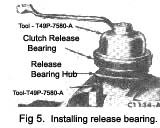If the bore alignment cannot be brought within limits by shimming, follow this procedure
- Remove the flywheel housing from the engine and remove the dowel pins. Install the flywheel housing and tighten the attaching bolts.
- Install the dial indicator (Fig. 2). Check the face alignment, and shim as required to bring face alignment within limits.
- Position the indicator to check the bore alignment (Fig. 3). If the bore alignment is not within limits, reduce the tension on the flywheel housing attach-ing bolts so that the housing can be moved by striking it with a lead hammer or a block of wood and a steel hammer.
- The lateral alignment should be brought within limits so that an indicator reading is within limits between the 9 o’clock and 3 o’clock positions on the bore circle. When the lateral alignment is within limits, the housing usually can be moved straight up or down without disturbing the lateral align-ment. When alignment is within limits, torque the housing bolts and recheck bore alignment.
- If the flywheel housing cannot be moved enough to bring the alignment within limits, mark the holes restricting movement, and then remove the housing and drill the marked bolt holes ~ in. larger.
- When the flywheel housing bore alignment is within limits and the attaching bolts are at normal torque, hand ream the dowel pin holes 1/32 in. larger. Use a straight reamer and ream from the flywheel housing side. Oversize dowel pins can be made from drill rod stock.
- Remove the flywheel housing and then install the oversize dowel pins in the cylinder block. Complete the assembly in the usual way.
|
CLEANING AND INSPECTION
Release Bearing
Wipe all oil and dirt off the release bearing. The bearing is prelubricated and should not be cleaned with solvent.
Inspect the bearing retainer for loose spring clips and rivets.
Inspect the release bearing assembly for burrs which may cause the assembly to drag on the gearbox bearing retainer. Any such burrs should be cleaned up with fine crocus cloth. If burrs are found, inspect the gearbox input shaft bearing retainer for evidence of scoring. Any scoring should be polished out with crocus cloth. Coat the bearing retainer with a thin film of lithium-base grease.
Hold the bearing inner race and rotate the outer race while applying pressure to it. If the bearing rotation is rough or noisy, replace the bearing.
When installing a release bearing, use the tool shown In Fig. 5.
Release bearing failure can be caused by the release lever contact points being out of plane. Check the wear on the release bearing assembly where the release lever contacts it.
If one side of the assembly shows more wear than the other, the release lever is bent out of plane, or is not centring on the bracket on the flywheel housing.
Misalignment between the engine and gearbox can cause release bearing failure. Other symptoms of misa-lignment are jumping out of gear, especially third gear, drive line vibration; excessive wear in the pilot bushing, excessive clutch disc spin time resulting in gear clash, and excessive gear wear.

|
 **
**
